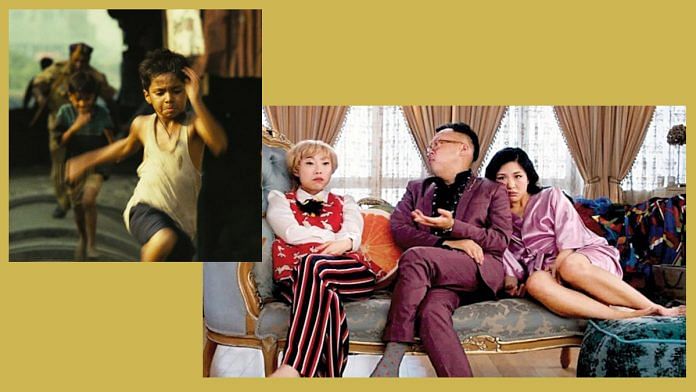American rom-com drama Crazy Rich Asians directed by Jon M. Chu released in India this week. After The Joy Luck Club, it was the first major Hollywood film to have a largely Asian American cast.
ThePrint asks: Enough Slumdog Millionaire, when will Hollywood make Crazy Rich Asians for Indians?
Want Hollywood to show you in a positive light, increase your wealth and earn it
 Achyut Mishra
Achyut Mishra
Journalist
India has multiple facets and Slumdog Millionaire showed one side of it. While we can criticise Hollywood if we feel that its depiction of that facet, i.e. India’s poverty, was inaccurate, we can’t expect it to focus on another facet that we believe might be more representative of India.
Crazy Rich Asians has Singapore as its backdrop which has a per capita income of more than $80,000 in PPP terms. Compare that with India, whose per capita income is yet to touch even $10,000. So even though we have our Ambanis and Tatas, we are still a long way from being a rich country.
In this case, China serves as a great example. Its phenomenal rise has completely altered its depiction in US movies, to the extent that Chinese space scientists are shown as saving Americans in a major production like The Martian. Increased Chinese investments in Hollywood studios and the size of China’s box-office market which is now just behind the US in value are the drivers behind this change. This changed depiction doesn’t imply that China has overcome all its problems but merely suggests that money can force others to ignore them.
What’s the moral of the story? Want Hollywood to show you in a positive light, increase your wealth and earn it. Only then will Hollywood start to ignore India’s poverty for its own good.
A film on the 1% “crazy rich Indians” is hardly representative of India either
 Fatima Khan
Fatima Khan
Journalist
A White man flew down to India and on observing the many things wrong with the country, decided to make a movie about it. Fair. Only that he couldn’t forget his Whiteness in the process.
Slumdog Millionaire was a grossly problematic movie which latched up all the possible clichés and used it to make a point about the ‘depravity’ of a third world country like India. A scene thoroughly exemplifying this is the one in which an Indian kid is beaten up by a crowd for stealing, and an American couple rushes to his rescue. The former act is termed as “Indian hospitality” and the latter, as “American generosity”. This is only one of the many with highly racist undertones. Brown people are willing to fall in a literal pool of shit, just for one glimpse of a superstar, whereas White people are seen as a bunch of generous and wise creatures.
The movie was a remarkable generalisation of all things Indian, coloured with a White man’s gaze. But in no way does that mean we should wait for Hollywood to make a movie depicting the 1 per cent “crazy rich” Indians. Because that’s hardly representative of India either. More importantly, the fact that we feel the need to turn to Hollywood for a sense of validation is also ridiculous. The truth is, Hollywood will make whatever is profitable. But each time, we need to be able to call them out on their misrepresentation.
Before asking ‘what about us’, we should celebrate rise in representation
 Nandita Singh
Nandita Singh
Journalist
Perhaps for a moment, it’s worth celebrating a rise in representation, for any non-White community, before we ask the ‘what about us’ question. Change, unfortunately or not, doesn’t happen overnight, and it doesn’t happen for everyone at once. We do, after all, have Priyanka Chopra on the billboards in Times Square, Mindy Kaling, Irfan Khan, Sacred Games on Netflix, Padma Lakshmi, Kal Penn (etc.). We do, after all, have Bend It Like Beckham, albeit in the UK. This isn’t a concession; I’m not saying we shouldn’t ask for more, but we should also ask for better.
While Crazy Rich Asians does propel the ‘Asian face’ into Hollywood mainstream cinema, it also presupposes and further propagates the idea that all Asians are, and look, the same. Indians aren’t nearly Asian enough, and the brown-people ‘subcontinent’ and its neighbours often get left out of this larger grouping, which in itself is stereotypical. ‘Africa’ has been fighting this battle for ages. I suppose Crazy Rich Chinese/Singaporeans just doesn’t quite have the same ring to it. Do you know which countries the cast of this movie belong to? Because I had to Google it and still couldn’t find an easy answer. The burden of diversity is the struggle of fighting for a common cause without your individual identity getting lost in it. It’s a hard bargain, and therefore, before asking ‘what about us,’ we need to decide for ourselves who this ‘us’ is – because clearly, we’re not the same Asians in the movie.
More actors like Priyanka, Irrfan and Deepika are already making headway in Hollywood
 Aastha Singh
Aastha Singh
Journalist
This question can be interpreted in two ways. First, Hollywood has more prominent examples of films based on India that highlight its aspect of poverty, inequality, underdevelopment and less of those that depict the life of an ordinary Indian in an urban setup. Second, Slumdog Millionaire, though, did have a strong Indian cast but unlike Crazy Rich Asians, its director and makers were largely Americans.
Crazy Rich Asians is being hailed for bringing together a cast and crew that did not need the engagement of professionals from an all-American, British or any other non-Asian origin. But then there are films like Lion, Life of Pi, Eat Pray Love, Gandhi that clearly portray setups based on India that are not limited to the factors mentioned above. Yes, the point is whether we have enough of such films. But I ask, do we really need them? Hollywood might not be making more films that explore the range of cultures, traditions, languages India boasts of, but in the past few years we have seen so many people making their mark in this industry: Priyanka, Irrfan, and Deepika lately.
Before Hollywood starts making films on urban, rich Indians, the perception about India as a largely third world country reeling under poverty, crime or lack of civic consciousness must be changed to a more pluralistic understanding of what this subcontinent is about. As far as ‘when’ is concerned, it’s difficult to predict but as I said, perception change is important before it happens. It really depends on from what angle India is being looked at.
Hollywood will never be able to truly represent Indians, neither can Bollywood
 Priyamvada Grover
Priyamvada Grover
Journalist
Ever been to a big fat Punjabi wedding? There is dance, music, glamour, drama and even action at times. You often find that these weddings are inspired by Bollywood fashion and music. You see the opulence that is displayed uninhibitedly, and you see the wealth that is shown off with no bounds. However, you hardly see these sequences when Indian lives are depicted in Hollywood films. You only see the boring old stereotypes being portrayed over and over- sad, poor people and some rich people with a gaudy fashion sense.
The West has finally begun to see India as a progressively developing country after seeing it as a land of snake charmers for decades. But that doesn’t cut it. It is lazy to think that we are all growing at the same rate. It is lazy to ignore the striking disparity between the rich and the poor. It is also lazy to ignore the various other overlapping classes that have emerged through time, and other social factors that govern the kind of lifestyle Indians follow. My problem with Slumdog Millionaire et al isn’t that they show poverty, but that they miss what is harder to depict, thus conforming to a homogeneous narrative.
However, I think that no matter what movie you make from the West’s point of view, it would never be able to truly represent the ‘Indians’, because no Bollywood movie has been able to do that yet either. And that’s because there isn’t one ‘Indian’ identity at all. But the least we can start doing is moving away from poverty porn and tap into these diverse identities to thread fresher narratives around.
By Neera Majumdar, journalist at ThePrint.




Indians love poverty, films on the rich will not be made. Our poverty loving politicians will ban any such movies.
Time for these whiny Indians to write a book, turn it into a best seller, then option off the movie rights for $1 and then, pass over a rich net flicks payday, so that it could be Hollywood made and shown on the big screen
What people in the west find hard to understand is that Indian people are very sensitive about films like Slumdog Millionaire which show the poverty and suffering in India, but they are not upset by the fact that successive governments have spent billions on nuclear weapons and a space programme instead of carrying out their first duty to the country, which is to provide adequate housing, education and health care.
As long as people do not demand it, why should the government bother ?